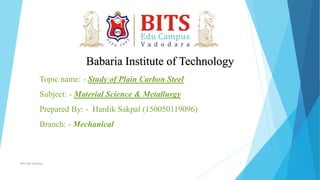
Study of Plain Carbon Steel
- 1. Babaria Institute of Technology Topic name: - Study of Plain Carbon Steel Subject: - Material Science & Metallurgy Prepared By: - Hardik Sakpal (150050119096) Branch: - Mechanical Bits edu Campus 1
- 2. The Primary Constituents of Plain Carbon Steel are Iron & Carbon. Plain carbon steel is a type of steel having a maximum carbon content of 1.5% along with small percentages of silica, sulphur, phosphorus and manganese. They can be used successfully only if the application does not have more strength & other engineering applications. Bits edu Campus 2
- 3. Classification of Plain Carbon Steel Low Carbon Steel Medium Carbon Steel High Carbon Steel Bits edu Campus 3
- 4. Low carbon steel Containing carbon up to 0.25% responds to heat treatment as improvement in the ductility is concerned but has no effect in respect of its strength properties. They are not improved in terms of strength & hardness properties by heat due to lack of carbon. The microstructure of low carbon steels consists of more amounts of ferrite & less amount of pearlite. They are relatively soft & weak but have extraordinary ductility & toughness. Bits edu Campus 4
- 5. Microstructure of low of Carbon steel Bits edu Campus 5
- 6. Applications Low Carbon steels are suitable for automobile & refrigerator bodies, cans, corrugated sheets , structural shapes, etc. Their applications also include nails, nut, bolts, boiler- plates, ship-plates, reinforcing bars, pipelines, etc. Bits edu Campus 6
- 7. Steel nuts Fence Steel wires Bits edu Campus 7
- 8. Medium carbon Steels: Medium carbon steels contain 0.3% to 0.6% carbon. They exhibit a better response to heat treatment compared to low carbon steels. Their Mechanical properties can be improved by hardening followed by tempering heat – treatments. By adding alloying, their ability to get hardened can be increased.Bits edu Campus 8
- 9. Microstructure of Medium Carbon Steel Bits edu Campus 9
- 10. Application Some typical applications of medium carbon steel include gears, axels, levers, cams, bolts, sockets, screw drivers, auger bits, cylinder liners, cylinders, hand tools, rims of bicycle & automobile-wheels, railway car- wheels & tracks, railways couplings, rifle barrels, balls of ball mill & machine components. Bits edu Campus 10
- 11. Balls of Ball Mill Axle Rims of bicycle Bits edu Campus 11
- 12. High Carbon Steels High carbon steels contain carbon from 0.6% to 2%. They are hardest and strongest among plain carbon steels but least ductile. They have poor formability, machinability & weldability as compared to medium carbon steel; but good hardenability. The alloying elements such as tungsten, molybdenum, chromium & vanadium can be added in these steels to form hard & wear resistant carbide compounds. Such high carbon steels with carbide compounds can be used for making tools & dies. Bits edu Campus 12
- 13. Microstructure of High Carbon Steel Bits edu Campus 13
- 14. Application The typical applications of high carbon steels include lock washers, valve springs, wrenches, cutting tools, dies, shearing knives, anvils, chisels, hammers, milling cutters, tapes, razors, hacksaw blades, piston rings & gauges. Bits edu Campus 14
- 15. Lock Washers Valve Springs Wrenches Bits edu Campus 15
- 16. Effect of impurity elements on properties of plain carbon steels There are four common impurity elements in plain carbon steels a. Silicon b. Manganese c. Sulphur d. Phosphorus. The properties of plain carbon steels primarily depend upon the carbon content & to a large extent upon these four impurity elements.Bits edu Campus 16
- 17. Silicon Its content in plain carbon steel varies from 0.05% to 0.30% . It is a good strengthened of ferrite in steels. It increases strength, hardness & toughness without loss of ductility. It is strong deoxidizer and removes dissolved gases & oxidizes during solidification of steel. Bits edu Campus 17
- 18. Manganese The manganese content in plain carbon steel varies from 0.3% to 1.0%. It decreases the harmful effect of sulphur, i.e. brittleness at high temperature by forming MnS thereby reducing content of FeS. It increases the hardenability of the steel. It dissolves in ferrite 7 increases yield strength, tensile strength, toughness & ductility considerably. Bits edu Campus 18
- 19. Sulphur Normally, sulphur content in the steel should be allowed to exceed 0.05%. The inclusions of FeS soften & may melt at rolling or forging temperatures reducing the tenacity of the hot metal & sometimes causing disintegration by cracking in the rolls or under the hammer. This is called as hot shortness or hot embrittlement. Bits edu Campus 19
- 20. Phosphorus The maximum content of phosphorus does not exceed 0.04%. Phosphorus dissolves in ferrite, increasing strength, hardness & improving the resistance to corrosion. So, it is added to low carbon steels up to 0.12%. It is added to improve machinability of certain grades of free cutting steels up to a maximum content of 0.12%. Bits edu Campus 20
- 21. Limitations of Plain Carbon Steel I. The strength of plain carbon steels cannot be increased beyond 700 Mpa without substantial loss in ductility & impact strength. II. They have poor impact strength at low temperatures. III. They have poor corrosion resistance & oxidation resistance. IV. Properties do not remain uniform for larger thickness of plain carbon steels. V. They are not deep hardenable.Bits edu Campus 21
- 22. Bits edu Campus 22
